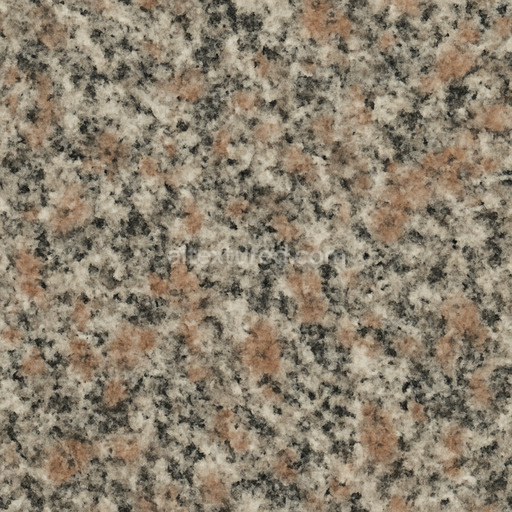The Realistic Granite Seamless Texture is an expertly crafted AI-generated material designed to replicate the intricate composition and visual complexity of natural granite rock surfaces. Granite is an igneous rock primarily composed of interlocking mineral crystals such as quartz, feldspar, and mica, which together form a dense, coarse-grained substrate. This texture captures these mineral aggregates with precision, showcasing subtle grain orientation and natural variations in porosity and weathering that occur over time. The surface finish is represented with a balanced semi-polished look, reflecting granite’s typical fine crystalline structure and slight surface sheen without appearing overly glossy or artificial. Colorants within the texture mimic natural oxide layers and mineral pigmentations, delivering a warm yet neutral palette that enhances realism across various lighting conditions and environments.
In terms of physically based rendering (PBR) workflows, this tileable realistic granite seamless texture excels in delivering authentic material representation across all relevant channels. The BaseColor (Albedo) map accurately portrays the natural coloration and mineral speckling of granite, while the Normal map adds depth by simulating the rock’s rough microstructure and subtle surface undulations. The Roughness channel is finely tuned to reflect the natural variations in surface reflectivity, presenting areas of polished crystalline faces alongside rougher, weathered patches. The Metallic channel is minimal, consistent with granite’s non-metallic nature, ensuring realistic light interaction without metallic reflections. Ambient Occlusion enhances the perception of crevices and grain boundaries, adding dimensionality, and the Height/Displacement map provides additional surface breakup for enhanced parallax effects and realistic depth perception, especially at close viewing distances.
Optimized for high fidelity projects, this seamless realistic granite seamless texture supports resolutions up to an impressive 8K, enabling crisp detail even on large-scale surfaces without visible seams or repetition artifacts. It integrates smoothly with leading 3D software and real-time engines such as Blender, Unity, and Unreal Engine, requiring minimal setup to implement. This makes it ideal for cinematic renders, real-time scenes, level dressing, and material studies focused on rock textures. For best results, it is recommended to adjust UV scaling to maintain natural grain size relative to scene scale and to combine the texture with subtle ambient occlusion and a light normal pass to enhance surface breakup without oversharpening. Additionally, fine-tuning roughness can help to achieve the desired balance between polished and weathered granite appearances in different lighting environments. Incorporating this AI texture realistic granite seamless texture into your material library will significantly accelerate your rock workflows with a clean, repeatable pattern that scales elegantly across all your projects.
How to Use These Seamless PBR Textures in Blender
This guide shows how to connect a full PBR texture set to Principled BSDF in Blender (Cycles or Eevee). Works with any of our seamless textures free download, including PBR PNG materials for Blender / Unreal / Unity.
What’s inside the download
*_albedo.png — Base Color (sRGB)*_normal.png — Normal map (Non-Color)*_roughness.png — Roughness (Non-Color)*_metallic.png — Metallic (Non-Color)*_ao.png — Ambient Occlusion (Non-Color)*_height.png — Height / Displacement (Non-Color)*_ORM.png — Packed map (R=AO, G=Roughness, B=Metallic, Non-Color)

Quick start (Node Wrangler, 30 seconds)
- Enable the addon: Edit → Preferences → Add-ons → Node Wrangler.
- Create a material and select the Principled BSDF node.
- Press Ctrl + Shift + T and select the maps
albedo, normal, roughness, metallic (skip height and ORM for now) → Open.
The addon wires Base Color, Normal (with a Normal Map node), Roughness, and Metallic automatically.
- Add AO and Height using the “Manual wiring” steps below (5 and 6).
Manual wiring (full control)
- Create a material (Material Properties → New) and open the Shader Editor.
- Add an Image Texture node for each map. Set Color Space:
- Albedo → sRGB
- AO, Roughness, Metallic, Normal, Height, ORM → Non-Color
- Connect to Principled BSDF:
albedo → Base Colorroughness → Roughnessmetallic → Metallic (for wood this often stays near 0)normal → Normal Map node (Type: Tangent Space) → Normal of Principled.
If details look “inverted”, enable Invert Y on the Normal Map node.
- Ambient Occlusion (AO):
- Add a MixRGB (or Mix Color) node in mode Multiply.
- Input A =
albedo, Input B = ao, Factor = 1.0.
- Output of Mix → Base Color of Principled (replaces the direct albedo connection).
- Height / Displacement:
Cycles — true displacement
- Material Properties → Settings → Displacement: Displacement and Bump.
- Add a Displacement node: connect
height → Height, set Midlevel = 0.5, Scale = 0.02–0.08 (tune to taste).
- Output of Displacement → Material Output → Displacement.
- Add geometry density (e.g., Subdivision Surface) so displacement has polygons to work with.
Eevee (or lightweight Cycles) — bump only
- Add a Bump node:
height → Height.
- Set Strength = 0.2–0.5, Distance = 0.05–0.1, and connect Normal output to Principled’s Normal.
Using the packed ORM texture (optional)
Instead of separate AO/Roughness/Metallic maps you can use the single *_ORM.png:
- Add one Image Texture (Non-Color) → Separate RGB (or Separate Color).
- R (red) → AO (use it in the Multiply node with albedo as above).
- G (green) → Roughness of Principled.
- B (blue) → Metallic of Principled.
UVs & seamless tiling
- These textures are seamless. If your mesh has no UVs, go to UV Editing → Smart UV Project.
- For scale/repeat, add Texture Coordinate (UV) → Mapping and plug it into all texture nodes.
Increase Mapping → Scale (e.g., 2/2/2) to tile more densely.
Recommended starter values
- Normal Map Strength: 0.5–1.0
- Bump Strength: ~0.3
- Displacement Scale (Cycles): ~0.03
Common pitfalls
- Wrong Color Space (normals/roughness/etc. must be Non-Color).
- “Inverted” details → enable Invert Y on the Normal Map node.
- Over-strong relief → lower Displacement Scale or Bump Strength.
Example: Download Wood Textures and instantly apply parquet or rustic planks inside Blender for architectural visualization.
To add the downloaded texture, go to Add — Texture — Image Texture.

Add a node and click the Open button.

Select the required texture on your hard drive and connect Color to Base Color.


